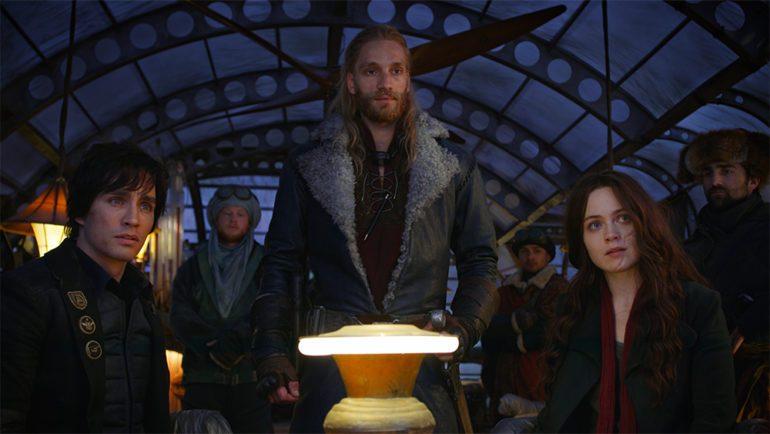Film Review: ‘Mortal Engines’
By Andrew Barker
LOS ANGELES (Variety.com) – For the first 10 minutes of dystopian sci-fi saga “Mortal Engines,” a blessedly enjoyable interval before you start to realize just what a long slog you have in store, director Christian Rivers stages a most unusual chase sequence. In this chase, the pursued is a small mobile mining town called Salthook, constructed to fold itself up like a hydraulic steampunk Transformer and drive away at the first sign of danger. The pursuer is the city of London, mounted on 200-foot-tall tank treads and rearranged into a teaming vertical monstrosity, with St. Paul’s Cathedral on top, and the London Eye repurposed as a sort of spinning subway transporting citizens from one tier of town to another.
The film, based on the first installment of Philip Reeve’s four-novel YA series, is set several centuries in the future, after a calamitous war has turned the planet into a barren wasteland, leaving giant mobile “predator cities” to literally roam the earth attacking and subsuming poor towns and villages. After a pursuit, London inevitably conquers the helpless hamlet to plunder its resources and consign its inhabitants to low-level jobs: a process the film calls “Municipal Darwinism.” It’s an interesting, exciting sequence, and it’s also not a bad metaphor for late-stage capitalism. Unfortunately, it’s also the last time “” displays anything recognizable as wit or dramatic invention, as the movie devolves from promising to unwieldy, then baffling, then exhausting, then finally unintentionally hysterical.
Here making his directorial debut, Rivers spent years as a storyboard artist and a visual effects supervisor for Peter Jackson (who produced this film and wrote the screenplay alongside Fran Walsh and Philippa Boyens), and he’s inherited a good deal of his longtime collaborator’s love for mythic world-building and hyperreal CGI spectacle. He’s gleaned little of Jackson’s facility with actors or characterization, however, and “Mortal Engines” starts to sputter as soon as we’re introduced to our dramatis personae.
Shaggy-haired and hapless, Tom Natsworthy (Robert Sheehan) is an apprentice at the Museum of London, specializing in the technology of “the ancients” – in other words, us. His talents attract the attention of the imperious Thaddeus Valentine (Hugo Weaving), a vaguely populist authority figure with an unusual interest in collecting rusted 21st century flash drives and appliances. The two men soon find themselves together in the bowels of the wheeled city, sorting through Salthook’s bric-a-brac alongside Thaddeus’ daughter Katherine (Leila George), when a masked young woman named Hester Shaw (Hera Hilmar) emerges from a crowd of refugees. “This is for my mother,” she yells, and stabs Thaddeus, non-fatally.
Tom, whose primary qualification to be the film’s protagonist appears to be his innate ability to take the most baffling and foolhardy course of action at almost every turn, gives chase, pursuing Hester through a deadly maze of spinning gears and blades. He catches up to her, but the two are promptly thrown down a garbage chute by Thaddeus, wasting no time in laying his villain cards on the table. Now stranded in the middle of the wasteland, the pair form an odd-couple partnership as they try to evade roaming lowlifes and make their way back to the city. Meanwhile in London, Thaddeus pursues a plan to build some sort of mysterious super-weapon, while Katherine and a scruffy local mechanic, unpromisingly named Bevis Pod (Ronan Raftery), try to get to the bottom of it.
Thaddeus, eager to apprehend Hester and Tom before they can thwart his evil plot, dispatches a half-machine-half-zombie creature named Shrike (Stephen Lang) to track and kill them, and it’s here that the film finally and truly goes flying off the rails. It’s not just that Shrike stalks the earth like a lumbering Boris Karloff parody, nor is it that his name bears an unfortunate sonic resemblance to “Shrek!” when it’s screamed out loud in terror, but the creature also has a complicated backstory with Hester that takes up a good deal of the film’s middle third. This reviewer has not read the source material, and perhaps their relationship makes some sort of sense therein, but it would have taken some incredibly deft handling to make Shrike’s story hit the emotional beats it’s supposed to hit onscreen. Here it misses by a mile.
The film never really recovers, but then little about it suggests it was heading toward solid ground anyway. For all its flashy digital scene-setting, “Mortal Engines” is rarely capable of staging impactful sequences within that scenery, and attempts to draw broad parallels to Brexit and Trump’s family separation policy fall quite flat. After cribbing from “Mad Max,” “Howl’s Moving Castle,” “BioShock Infinite,” and “The Terminator” throughout, the film finally throws up its hands and goes full “Star Wars” for its desultory finale, hurriedly introducing a band of rebel pilots called the Anti-Traction League, led by notorious outlaw Anna Fang (Jihae, attempting to convey badassery by holding a single facial expression for the entire film).
You certainly can’t accuse Rivers of undue subtlety, with every emotion dialed up to 11 at all times, matched for volume by Junkie XL’s maximalist, omnipresent score. But the film never captures the bonkers, go-for-broke energy that made the ill-fated likes of “Cloud Atlas” or “Valerian and the City of a Thousand Planets” such enjoyable noble failures, too caught up in hitting the same old blockbuster beats to stop and wonder where the story’s weirder threads might have lead. It’s hard not to think back to that opening scene, as yet another interesting, funky property is gobbled up by a lumbering franchise filmmaking empire that doesn’t know quite what to do with it.

